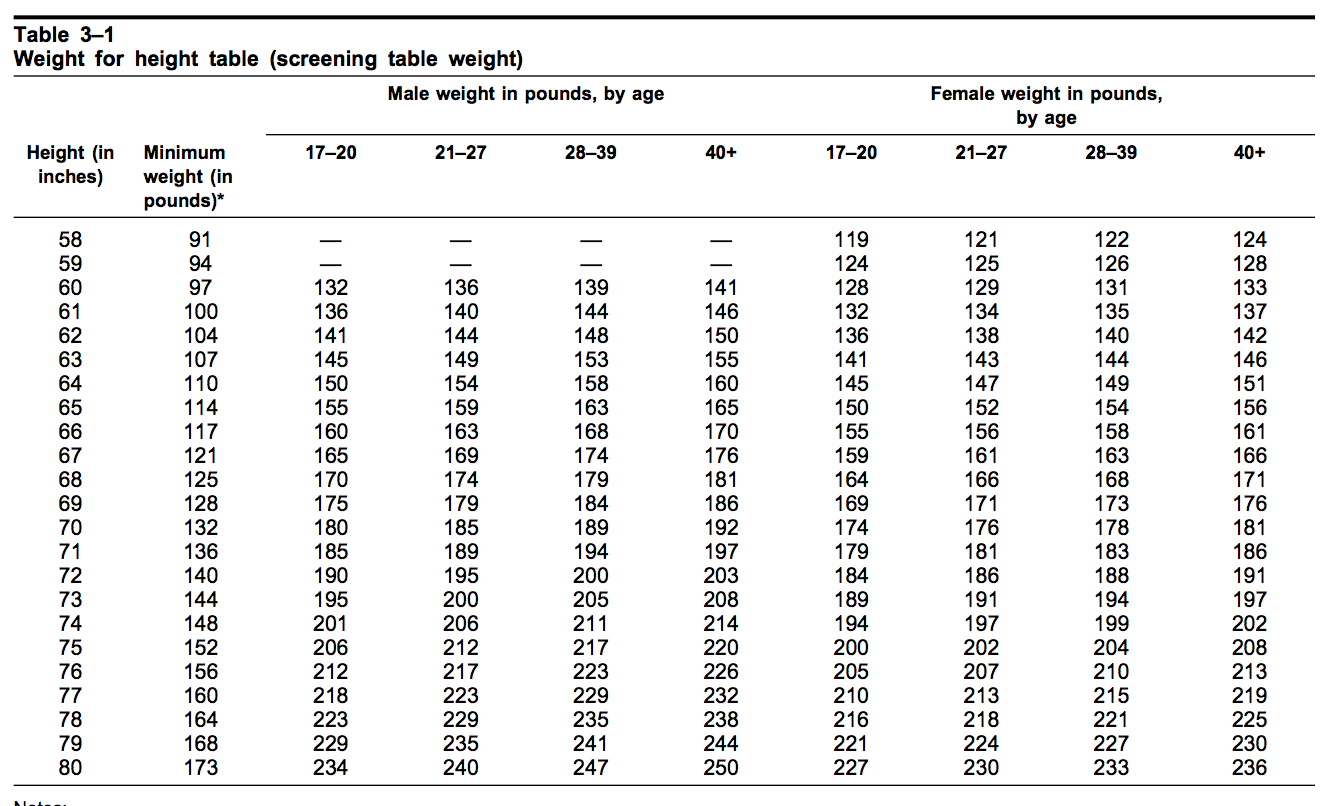Understanding Army Height And Weight Standards: A Comprehensive Guide
The Army height and weight standards are critical for maintaining the physical readiness and overall effectiveness of military personnel. These standards are not just arbitrary numbers; they are based on extensive research aimed at ensuring soldiers are fit for duty and capable of performing their roles effectively. In this article, we will delve into the details of the Army’s height and weight standards, exploring their significance, how they are measured, and the implications for service members.
Maintaining optimal physical fitness is essential for soldiers, who are often required to engage in demanding tasks that require strength, endurance, and agility. The Army's height and weight standards serve as a benchmark for assessing whether personnel meet the necessary physical requirements. This article aims to provide an in-depth understanding of these standards, including how they are applied and the processes involved in measuring compliance.
As we explore this topic, we will also touch upon the implications of these standards for recruits and current soldiers, including the potential consequences of not meeting the standards. Whether you are considering joining the Army or are simply interested in understanding military fitness protocols, this guide will equip you with valuable insights.
Table of Contents
- 1. Overview of Army Height and Weight Standards
- 2. Importance of Height and Weight Standards in the Army
- 3. How Army Height and Weight are Measured
- 4. Army Height and Weight Standards by Age and Gender
- 5. Implications of Failing to Meet Standards
- 6. How to Achieve and Maintain Army Height and Weight Standards
- 7. Common Myths About Army Height and Weight Standards
- 8. Conclusion and Takeaways
1. Overview of Army Height and Weight Standards
The Army height and weight standards are defined in Army Regulation 600-9. These standards are designed to ensure that soldiers are not only of a certain height but also maintain a weight that is proportionate to their height. The standards vary based on age and gender, acknowledging the different physical characteristics of individuals.
The height and weight standards are as follows:
- Maximum allowable weight is determined by height.
- Body fat percentage is also considered in determining whether a soldier meets the standards.
1.1. Measurement Techniques
The Army uses specific techniques for measuring height and weight. Height is measured without shoes, while weight is recorded using calibrated scales. These measurements are taken during regular assessments to ensure compliance with the standards.
2. Importance of Height and Weight Standards in the Army
Maintaining height and weight standards is crucial for several reasons:
- Operational Readiness: Soldiers must be physically fit to perform their duties effectively.
- Health and Safety: Excess body weight can lead to health issues and injuries.
- Professionalism: Meeting these standards reflects discipline and commitment to military service.
3. How Army Height and Weight are Measured
The process of measuring height and weight in the Army involves a few simple steps:
- Soldiers remove shoes and heavy clothing.
- Height is measured using a wall-mounted stadiometer.
- Weight is recorded on a calibrated scale.
- Body fat percentage is calculated using specific methods if weight exceeds the maximum allowable limit.
4. Army Height and Weight Standards by Age and Gender
The Army has specific height and weight standards that vary according to age and gender:
- For males aged 17-20, the maximum weight is typically higher than that for females.
- As soldiers age, the standards may adjust slightly to accommodate changes in body composition.
4.1. Example Standards
Here’s a brief overview of some example standards:
| Age Group | Gender | Maximum Weight (lbs) |
|---|---|---|
| 17-20 | Male | 191 |
| 17-20 | Female | 164 |
| 21-27 | Male | 201 |
| 21-27 | Female | 171 |
5. Implications of Failing to Meet Standards
Failing to meet the Army height and weight standards can have serious consequences:
- Reassignment: Soldiers may be reassigned to non-combat roles.
- Disciplinary Actions: Continued failure to meet standards may lead to disciplinary actions.
- Separation from Service: In extreme cases, soldiers may be separated from the Army.
6. How to Achieve and Maintain Army Height and Weight Standards
To meet and maintain the Army height and weight standards, soldiers can follow these guidelines:
- Regular Exercise: Engage in a balanced fitness routine that includes cardio and strength training.
- Healthy Diet: Focus on a diet rich in fruits, vegetables, lean proteins, and whole grains.
- Stay Hydrated: Drink plenty of water to support overall health.
7. Common Myths About Army Height and Weight Standards
There are several myths surrounding the Army height and weight standards that can lead to confusion:
- Myth: Height and weight are the only indicators of fitness.
- Myth: Only overweight soldiers are subject to assessment.
8. Conclusion and Takeaways
In summary, the Army height and weight standards serve as essential benchmarks for maintaining the physical readiness of soldiers. Understanding these standards is vital for anyone considering a career in the military or for current service members. By adhering to these standards, soldiers contribute to their own health and the effectiveness of their units.
We encourage readers to leave comments, share this article, or explore more related content on our website to stay informed about military standards and fitness.
Thank you for reading! We hope to see you back here for more informative and engaging articles.
Exploring The Life And Career Of Matt Czuchry
Jennifer Grant: The Life And Career Of A Talented Actress
Understanding The Recall On Instant Noodles: What You Need To Know


